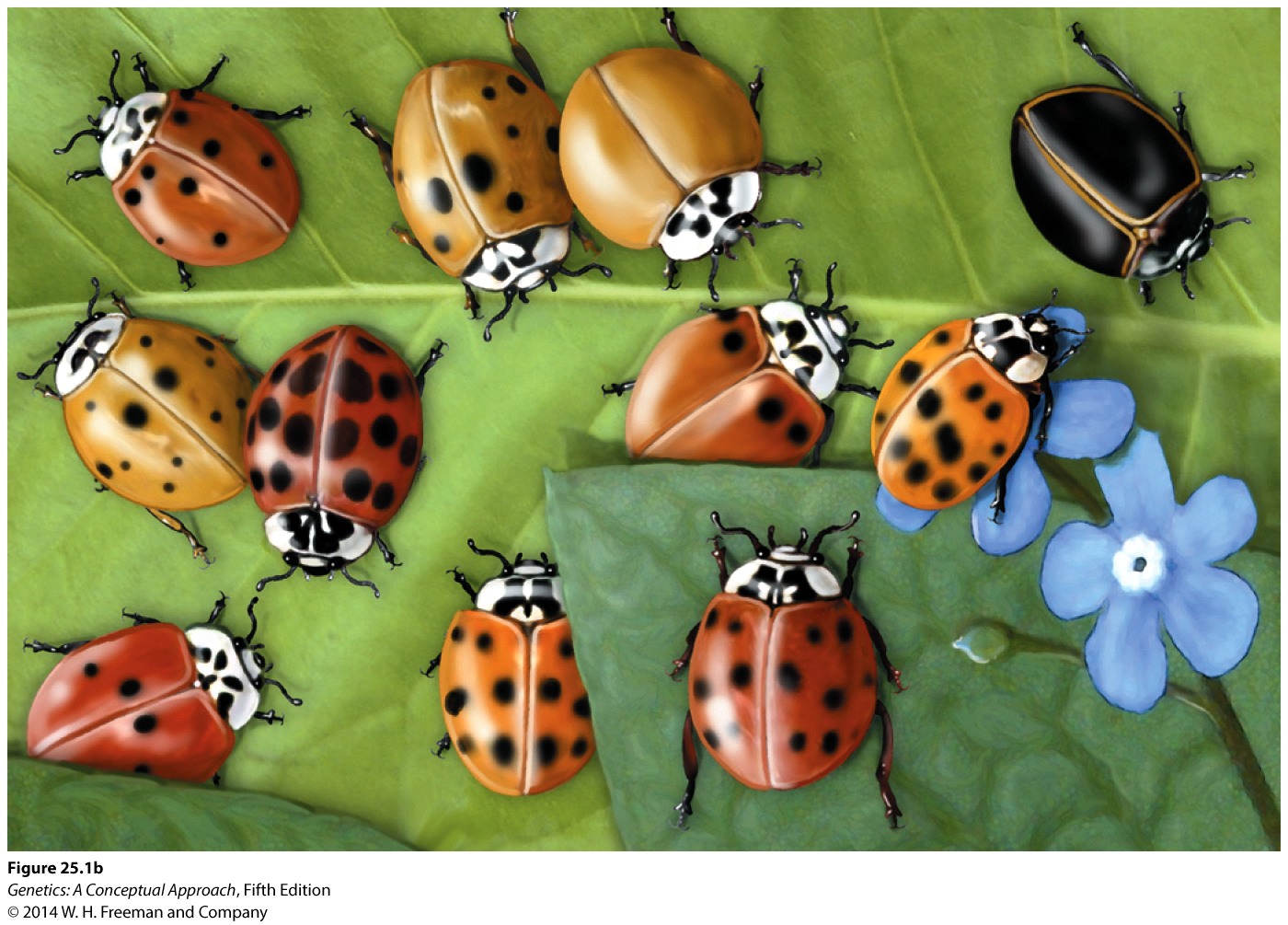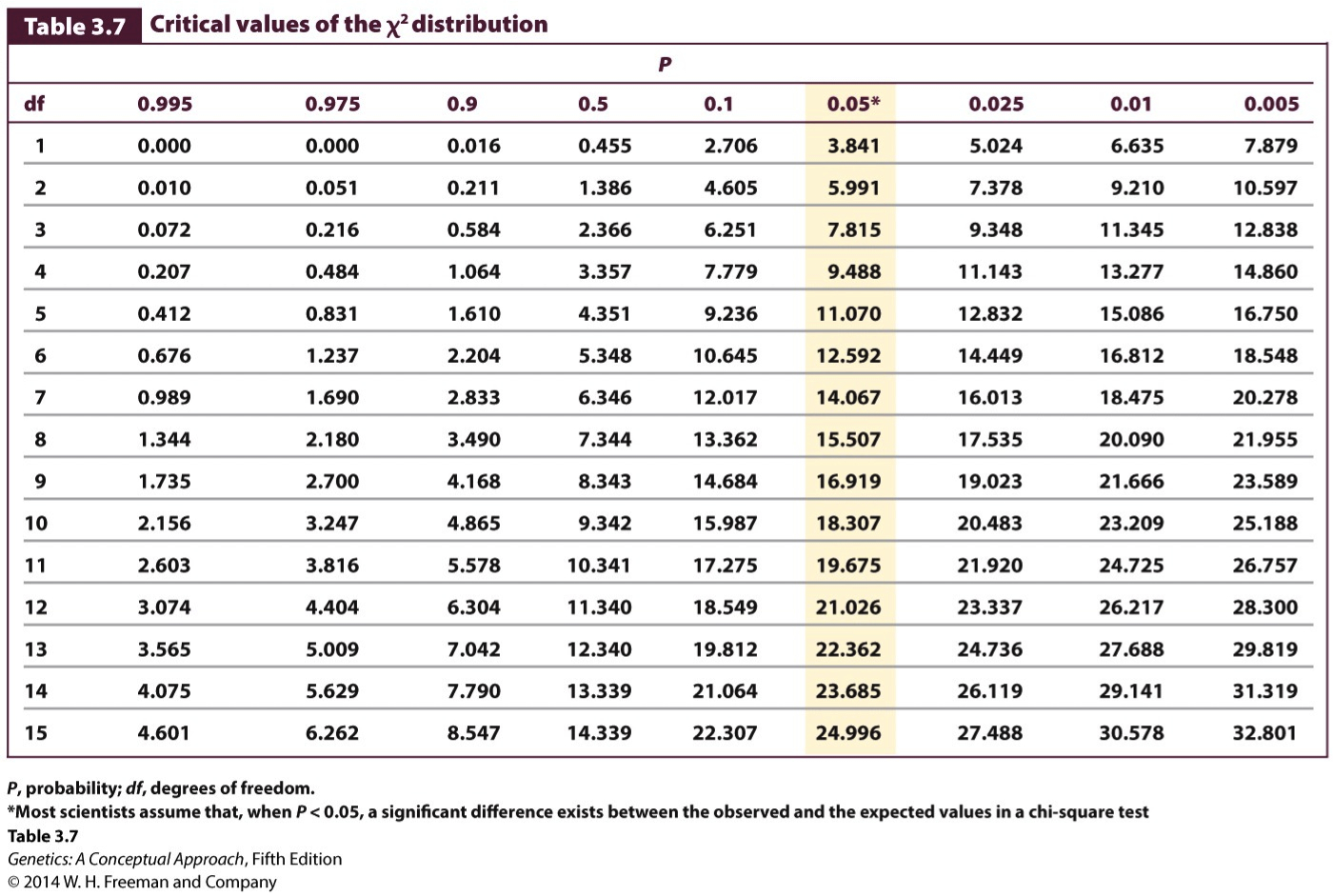Chapter 25 Branched Tutorial: Hardy-Weinberg
Problem Statement

Assume that the phenotypes of lady beetles shown in the figure at the right are encoded by the following genotypes:
| Phenotype | Genotype |
|---|---|
| All black | BB |
| Some black spots | Bb |
| No black spots | bb |
For the lady beetles shown in the figure, calculate the frequencies of the genotypes and frequencies of the alleles. Determine if the population is in Hardy-Weinberg equilibrium by using a chi-square test. Be sure to round your answer to 2 decimal places.
Question
| Genotypes: | |
|---|---|
| Frequency of BB | |
| Frequency of Bb | |
| Frequency of bb | |
| Alleles: | |
| Frequency of B | |
| Frequency of b |
Use a chi-square test to determine if the lady beetles shown are in Hardy Weinberg equilibrium.
Chi-square value =
Problem Strategy
Question
Determine the best approach to solve this problem by ordering the following steps:
- Determine the allele frequencies in the population.
- Determine the genotypic frequencies in the population.
- Interpret the chi-square value.
- Identify the question that is being asked and focus on key pieces of information.
- Conduct a chi-square test.
- Determine the expected number of individuals in each class if the population is in Hardy-Weinberg equilibrium.
Which of the following is the correct order of steps that should be used to solve this problem?
| A. |
| B. |
| C. |
| D. |
Instant TA
Think about the steps listed and how they logically flow from one to another, from general, information-gathering steps to more specific steps related directly to the question.
Step 1: Understanding the Problem
Question
1. How many individuals are in this population?
| A. |
| B. |
| C. |
Instant TA
You will need to count the total number of lady beetles in this population.
Step 2: Calculating Genotypic Frequencies
Question
1. Indicate the total number of black lady beetles in the figure.
Number of black lady beetles =
Instant TA
Use the displayed figure to count the total number of lady beetles that are all black.
Step 3: Calculating Allele Frequencies
Question
1. Indicate the correct values for nBB, nBb, and N in the following equation:
p = f(B) = (2nBB + nBb)/2N
p will represent the frequency of the B allele. nBB and nBb represent the number of individuals of each genotype. N represents the total number of individuals in the population.
nBB =
nBb =
N =
Instant TA
Identify the number of individuals with genotype BB and genotype Bb.
More About This Equation
In this equation, the frequency of the B allele is being represented by p. In order to calculate p, the total number of B alleles and total number of alleles in the population are needed. 2nBB represents the number of B alleles in the homozygotes (remember, for each homozygous individual there are two alleles—this is why we multiply the number of individuals with genotype BB by two). nBb represents the total number of B alleles in the heterozygotes (since each individual only has one B allele, there is no need to multiply by any factor). 2N represents the total number of alleles in the population (each individual has two alleles at each locus).
Step 4: Calculating Expected Genotypic Frequencies for a Population in Hardy-Weinberg Equilibrium
Question
1. In the Hardy-Weinberg equilibrium equation, which expression represents the expected frequency of the BB genotype?
p2 + 2pq + q2 = 1
| A. |
| B. |
| C. |
Instant TA
We are letting p represent the frequency of the B allele. The BB genotype has 2 B alleles.
Step 5: Conducting a Chi-Square Test
Question
1. A table can help organize your calculations for the chi-square test. In the table, the letters A-E represent column headings. To provide the best approach to arriving at the final chi-square value, use the dropdown menus below to match the correct column heading title with the correct letter.
| A | B | C | D | E | |
|---|---|---|---|---|---|
| BB (all black) | |||||
| Bb (some black spots) | |||||
| bb (no black spots) |
(Observed - Expected)2/Expected
Expected
Observed
Observed - Expected
(Observed - Expected)2
Instant TA
The column indicated by “A” should include the information that is provided to you. In the remaining columns, you will work in a stepwise manner to obtain the values that will be used for the chi-square calculation.
Show Chi-Square Equation
χ2 = Σ(observed - expected)2 / expected
Step 6: Interpreting the Chi-Square Value
Question
1. How many degrees of freedom should be used to determine the significance of the chi-square value?
| A. |
| B. |
| C. |
Instant TA
Generally, the degrees of freedom for a chi-square test of Hardy–Weinberg equilibrium equal the number of expected genotypic classes minus the number of associated alleles.
